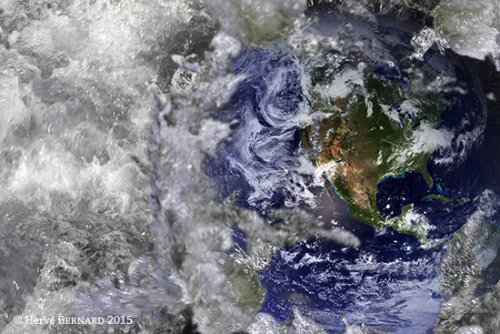The Holocene hangover : it is time for humanity to make fundamental changes
Excerpt from an article published in the Guardian, published on Wednesday 7 December 2016
[...]
Now the science fiction dream of leaving the planet behind appears to be coming true. One of the most striking effects of climate change — often remarked upon by writers — is its power to unsettle our basic understanding of the modern world. Our planet is changing into a strange and unstable new environment, in a process seemingly outside technological control. The fossil fuels that once promised mastery over nature have turned out to be tools of destruction, disturbing the basic biogeochemical processes that make our world habitable. Even the recent past is no longer what we thought it was. Scientists are telling us that the whole territory of modern history, from the end of World War II to the present, forms the threshold to a new geological epoch.
[...]
Our new planet is emerging quickly. The global climate is only one of nine earth system processes under threat. Land use is changing rapidly thanks to urbanization, agriculture, and population pressure. The rate of biodiversity loss is increasing in many ecosystems. Acidification is affecting marine biodiversity as well as the capacity of oceans to absorb carbon dioxide. The supply of fresh water in many regions is deteriorating. Aerosol loading and ozone depletion threaten the stability of the earth system’s atmosphere. Industrial agriculture has perturbed the global nitrogen and phosphorus cycles. Finally, chemical pollution may pose a risk not just at the local or regional level but also worldwide. Indeed, the planet’s biosphere bears so many marks of anthropogenic influence that it no longer possible to uphold the age-old distinction between the realm of wilderness and the world of human habitation.
To call attention to this unprecedented danger, the atmospheric chemist Paul Crutzen and the ecologist Eugene Stoermer in 2000 proposed a new name for the geological epoch we inhabit : the Anthropocene. Crutzen and Stoermer picked 1784 as the origin of the new epoch : the year of James Watt’s patent for a steam engine with a separate condenser.
[...]
From a geological perspective, the dating of the Anthropocene turns on the problem of how to identify a stable and durable stratigraphic signal that might be detected by observers in a distant future. What sort of fossils will we leave behind ? Geologists sometimes joke about the Coca-Cola layer of modern civilization. Among the plausible candidates proposed by the Working Group on the Anthropocene are microplastics, metal alloys, and artificial isotopes. Such stratigraphic markers must be placed in their historical context. The scientific identification of the Anthropocene with the year 1945 gives us not just a plausible geological end to the Holocene, but also a watershed that fits comfortably with a great body of scholarly work about the historical consequences of World War II.
The Great Acceleration, like the Anthropocene, is a concept of fairly recent coinage. It surfaced in an interdisciplinary workshop in 2005 and was popularized by Will Steffen in the discourse on planetary change. The name was meant to echo Karl Polanyi’s famous thesis about the rise of market society and the social basis of all economies. But the Great Acceleration takes Polanyi’s approach a step further by suggesting an environmental foundation to economic development. Postwar growth must be understood in not only its social but also its biophysical context. In scientific terms, the Great Acceleration captures the systemic and interrelated impacts of economic development on the biosphere. It is closely connected to the idea of “planetary boundaries” put forward in 2009 by the environmental scientist Johan Rockström and his group of collaborators.
[...]
“Planetary boundaries” represent approximate quantitative values for thresholds of environmental risks beyond which we can expect nonlinear and irreversible change on a continental or planetary level. Most famously, climate scientists have warned that any carbon emissions above 350 parts per million (ppm) represents unacceptable danger to the welfare of the planet and humanity. The big rise in emissions that brought us past this threshold happened in the past three generations. While the origin of fossil fuel burning goes back to the Industrial Revolution (which set us on an emissions path beyond the Holocene’s natural variability of 260 to 285 ppm), the truly dramatic rise in carbon dioxide emissions, from 310 to 400 ppm, has occurred between 1950 and 2015. The concept of the Great Acceleration encourages us to conceive of postwar capitalism as a biogeochemical process : the history of post-Fordism, the triumph of the welfare state, les trente glorieuses, and the rise of the BRIC powers all contributed to the upward trend of emissions and the increasing disequilibrium of the carbon cycle.
[...]
©Fredrik Albritton Jonsson for the Guardian
 Regard sur l’image
Regard sur l’image
